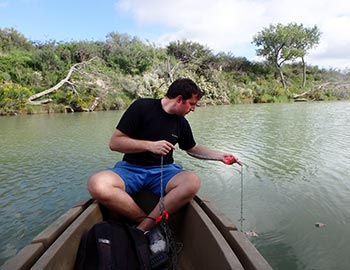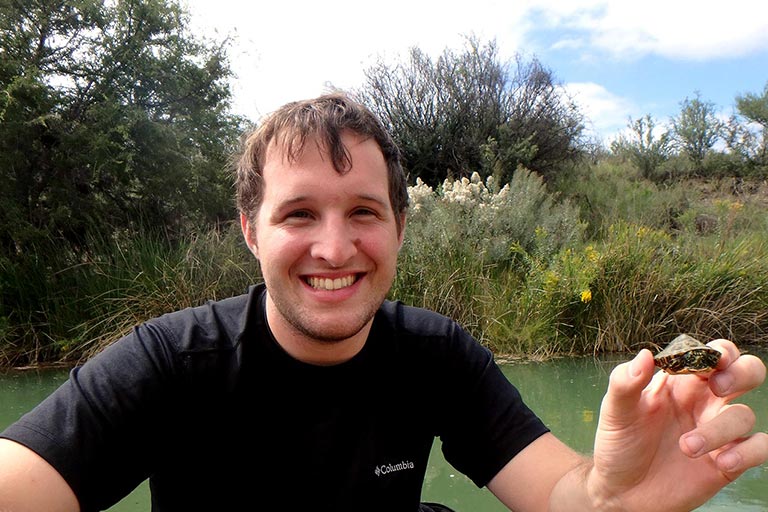Andrew Letter, an Eastern New Mexico University biology major who expects to graduate with a master's degree in the spring of 2018, completed a grant project funded by the New Mexico Water Resources Research Institute (NM WRRI) at New Mexico State University. The project was titled "Monitoring water quality parameters within a known range of Western River Cooter (Pseudemys gorzugi) within Black River Drainage."
His faculty supervisor was Dr. Ivana Mali, assistant professor of biology at ENMU.
Andrew conducted the study from September 2016 to June 2017 along two 1500-meter stretches of the Black River (tributary of the Pecos River) in Eddy County, New Mexico.
He says the "highlights of our research were being able to begin consistent long-term monitoring of the water quality along our two study sites on the Black River. We observed differences between the sites, which are separated by a subterraneous flow of the river. By collecting future data, we can test to see how these parameters change year to year and determine if they have any effects on other variables along the river, such as vegetation and algal growth."
The focus of his thesis research is the dietary habits of the Rio Grande Cooter (Pseudemys gorzugi).
According to Andrew, water quality along the river "may help to explain some of the dietary habits observed, which can help to design and implement plans to conserve this New Mexico state-threatened species."
Andrew says being involved with the water-quality project allowed him to observe and work in a new environment. Coming to New Mexico from growing up in Florida was "an interesting and exciting experience for me, filled with new environments and animals to learn about."
His first trip to Black River was last fall when his group camped a short drive away from their study sites at a campground in Whites City, New Mexico. Conducting the water quality research along the Black River allowed him to understand the river system better and to work with other graduate and undergraduate students who assisted.
Andrew says working with Dr. Mali and receiving the NM WRRI student grant opened up many opportunities and learning experiences. Under her guidance, he hopes to apply what he learned in his future career.
"Through the grant, our research project was funded and we were able to purchase equipment to test for different parameters along the river at our study sites," Andrew said. "I learned about the equipment and tools needed to monitor water quality, which was a new subject field to me.
"Previously, I had no experience with water quality research, but through this project, I was able to gain a new skill-set related to freshwater research. This project is long-term and will give future undergraduate and graduate researchers the opportunity to conduct side projects to better help understand Black River."
According to Andrew, the oil and natural gas industries have a negative effect on groundwater quality near Black River, which set the ground for a study investigating how the riverine environment itself has been affected (Inoue et al. 2014).
"The objective of my research was to obtain water quality parameters along the upper and lower stretches of Black River, within a range of the state-threatened turtle species, Western River Cooter," Andrew said, citing the work of Dr. Mali (Pseudemys gorzugi; Mali 2016).
The study investigated important water quality parameters including nitrogen compounds (ammonium and nitrate), dissolved oxygen, salinity, pH, turbidity, visibility, temperature, as well as conductivity, oxidation reduction potential and water depth.

"Black River is home to many species of plants and animals and also presents an important resource for terrestrial vertebrates. Humans continuously use the Black River for agricultural and industrial purposes, all of which are sources of nitrogen compounds to the river system," Andrew said.
In his final report, citing various sources, Andrew wrote:
"Ammonia, in particular, comes from living organisms, which then can transform into nitrate over time.
Nitrogen compounds can cause growth of aquatic plants, affect dissolved oxygen levels, visibility, turbidity, but ammonia itself can be toxic to fish and insects if in high enough concentration.
Dissolved oxygen levels can be affected by salinity and temperature. For example, high salinity or temperatures can decrease the amount of dissolved oxygen in the system.
Oxidation reduction potential is also important as a higher ORP can have antimicrobial effects in the water system. Given the interconnectedness of water quality parameters and anthropogenic effects on the river system itself, it is important to monitor these variables to help understand how these values play a role within an ecological system."
According to Andrew, Black River is a biodiverse system that contains many different types of organisms, including several threatened and endangered taxa such as Texas hornshell, blotched water snake and Rio Grande cooter.
"Obtaining water quality parameters may serve as an important component in understanding the overall productivity of this river system," Andrew said. "In the case of the Rio Grande cooter, water quality parameters can indirectly provide information on resource availability. For example, dissolved oxygen can potentially provide information on plant growth which is important given the herbivorous diet of adult P. gorzugi and temperature gradients can be correlated to the overall activity of this freshwater turtle given that they tend to be dormant in the cold winter months."
Andrew says his research shows how drastic or minimal water parameters can be between upstream and downstream locations along the river.
He plans to compose a collaborative publication in the future with additional research conducted at ENMU on population demographics of Pseudemys gorzugi funded through New Mexico Department of Game and Fish - Share with Wildlife Program.
Andrew says the grant from NM WRRI and his academic studies at ENMU have given him the opportunity to conduct research and present on different topics including water quality, differences in population demographics in Texas and New Mexico, the Rio Grande Cooter (Pseudemys gorzugi) and his thesis research regarding the diet of P. gorzugi.
"I have improved my presentation skills, field skills and how to communicate science to others through my coursework, teaching laboratories as a graduate teaching assistant, and from the research opportunities I have led or assisted with," Andrew said.
"I plan to take a year off after completion of my master's and get an internship where I can further hone my skills as a researcher before pursuing a Ph.D. in either landscape ecology or wildlife management.
"I would like to thank the New Mexico Water Resources Research Institute for providing the funding for this opportunity, Dr. Mali for guiding me and helping to answer my questions and the assistants (Jessica Curtis, Leslie Sanford, Keegan Friend, Daniel Gallegos, Korry Waldon) who helped with fieldwork."
Andrew presented the project at NM WRRI's 62nd Annual New Mexico Water Conference.



